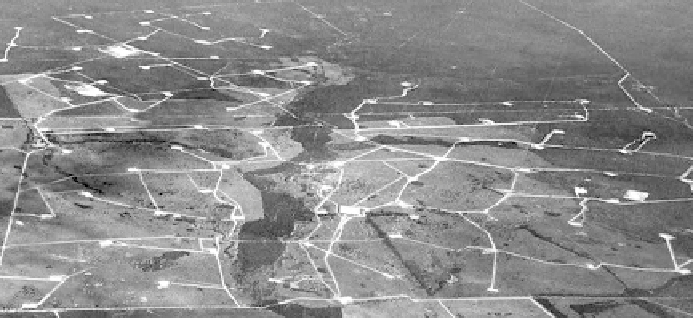Environmental Engineering Reference
In-Depth Information
Figure 3 CSG landscape, QLD.
(Source: Stop CSG, http://stopcsg.org/csg-risks/ last accessed 28/01/2014).
in about 10% of new wells but may eventually be used in as many as 40% of
aging wells in order to release the remaining but less accessible gas.
28
In
addition, fracking may become more prevalent as the most attractive re-
serves are fully developed and CSG extraction moves on to less favourable
sites. Seams that have plenty of natural fractures are less costly to develop,
and are thus more attractive to CSG operators, than those that are more solid
and need to be artificially fractured.
26
Most current CSG extraction in Aus-
tralia is occurring 250-1000metres below the land surface. However, as
Australian production taps into deeper coal seams or those less naturally
permeable, the need for fracking may increase from the current 10% of new
wells to upwards of 40%.
29
The issues surrounding fracking chemicals that are familiar to observers
of the US scene - reluctance of operators to provide information about what
chemicals and substances are being used, and instances where toxic and/or
carcinogenic chemicals have been identified in the vicinity of fracking sites -
also have arisen in Australia. CSG operators in Australia now are required to
announce what substances are used during fracking, an obligation that
seems to have motivated increasing use of environmentally friendly
chemicals.
30
CSG wells are typically networked across the landscape 750 m apart, linked by
service roads and by at least two sets of pipelines to move gas and waste water
out, and potentially a third set to bring fracking water in (see Figure 3). Waste
water is collected in holding ponds from where the announced intent, currently
honoured more often in the breach, is to move it on to treatment plants.
3.2 Environmental Impacts of CSG
CSG extraction on a large scale is a land-extensive but nevertheless intrusive
process entailing a considerable catalogue of potential environmental risks
and land-use conflicts - diminished water supply and quality, methane

